|
|
 |
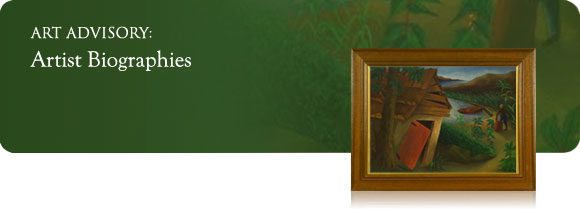
Alphabetical
A | B | C | D | E | F | G | H | I | J | K | L | M | N | O | P | Q | R | S | T | U | V | W | X | Y | Z
Paillou, Peter
Palmer, Michael
Pandya, Vasudeo H.
Paya, Emilio
Peeters, Henry
Perlmutter, Jack
Perrin, Charles Robert
|
Petit, Eugene
Picasso, Pablo
Pietrucha, Frank
Pindell, Pamela
Pissarro, Hughes Claude
Pradzynski, Thomas
Plunket, Jean Reasoner
|
|
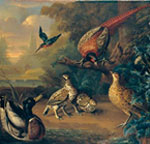
Peter Paillou
c. 1720- c. 1790
British bird painter and illustrator
Little is known of Paillou’s early life. He was given a commission to paint a gilded pheasant in 1745 and was employed by Thomas Pennant to paint pictures of birds, many of which were engraved by Peter Mazell for use as plates in Pennant’s books.
|
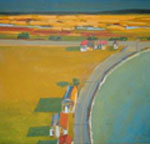
Michael Palmer
b. 1941
American abstract artist
Michael Palmer was born in Ogunquit, ME. He has painted, lived and worked in the islands and Florida for most of the past two decades. He is known for his abstract and landscape painting and has painted professionally for forty-two years. He has exhibited in many museums, fine art galleries throughout the United States and Canada.
|
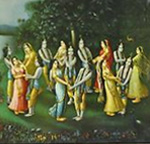
Vasudeo H. Pandya
-
19th – 20th Century Indian School artist
The 20th century Indian artist, Vasudeo Pandya is primarily known for his oleograph reproduction prints of classically themed scenes from the stories of Bhagavata Purana.
|
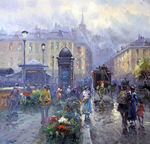
Emilio Paya
b. 1935
Spanish painter
Emilio Paya, known as Payes, was born February 28, 1935 in Alicante, Spain. At the age of fourteen, Payes attended the Arts and Crafts School in Alcoy from 1949-1953. Upon graduating, he studied with his professor, Edmundo Jorda, at the Fine Arts School in Alcoy from 1954-1958 and later attended La Salle College in Alcoy. At the age of twenty-eight, Payes decided to paint professionally and focused on scenes of everyday life. He was attracted to the famous boulevards of Paris, a scene that he is well known for today.
|
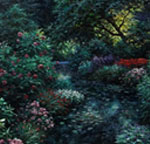
Henry Peeters (Hing Biu)
b. 1951
20th Century Chinese/American landscape artist
Henry Peeters was born in Canton, China in 1951. Hing Biu received his art training in China. His professional art career began in 1972 after receiving his degree from the Canton Fine Art University. He paints imaginary landscapes in the impressionist style.
|
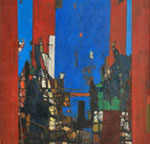
Jack Perlmutter
1920-2006
American Abstract realist artist
Jack Perlmutter was born in New York City. He showed an early aptitude for art and later moved to Washington and took a job in the Naval Oceanographic office as a lithographer where he learned the art of lithography by drawing and printing nautical charts. He went to Japan on a Fulbright scholar to study printmaking and lecture on American art. His works were typically built around recognizable urban scenes, such as railroad tracks, street scenes, buildings or bridges overlaid with busy linear forms, often in bright colors. He projected his excitement, love of rawness, newness, and the exciting, crushing city. However, because he currently has no gallery representation, the stated value is based on extrapolation from past auction sales.
|
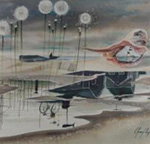
Charles Robert Perrin
1915-1999
Nantucket marine and landscape watercolorist
Charles Robert Perrin was born in Medfield, Massachusetts and graduated from the Art Institute of Boston. He first painted on Nantucket Island in 1946 where he opened a studio in 1956 on Old South Wharf, which became the first active gallery on the wharf. By 1966, he moved permanently to Washington Street where he demonstrated his watercolor technique in the summers. Originally an illustrator, Perrin illustrated Island children’s books and some of the first posters employed to market the island. In 1959, he converted a VW bus into a plein air studio on wheels. His work is represented in the Smithsonian American Art Museum and the Nantucket Historical Association. His prowess as a watercolor painter was credited in “One Hundred Watercolor Techniques”, together with renowned artists Andrew Wyeth and Ogden Plysmer. He is especially noted for paintings of foggy days on the waterfront and street scenes with reflective puddles.
|
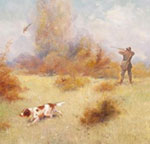
Eugene Petit
1839-1886
French Sporting artist
Eugene Petit was born in Paris. He specialized in painting genre and still life subjects, in particular flowers and fruit. He also painted a small collection of sporting dog pictures. He exhibited in the Salon de Paris in 1863 and 1873. His work is French museums in Carcassonne, Compiegne, Courtrai, Rouen and Saint-Etienne. The Ulman Mfg. Co. published prints of Petit’s works posthumously.
|
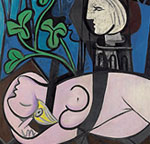
Pablo Picasso
1881-1973
Spanish Cubist painter
Pablo Picasso was born in Spain and lived most of his life either there or in France. His father was an art teacher, and the young Pablo grew up in an artistic environment. By the age of fourteen, he was an accomplished draftsman, and in 1900 at age nineteen, he made his first trip to Paris. Between 1901 and 1904, his work was dominated by a blue palette, which has led to this time being called his “Blue Period”. Blue, for him, was to symbolize the “suffering-frequently hunger and cold, the hardships he experienced while attempting to establish himself.” By 1905, his ‘Rose or Circus Period’ was beginning, and also later that year, he began creating paintings that reflected his growing interest in African masks. In 1908, Picasso began working in Paris with Georges Braque, and together, until 1914 and the beginning of World War I, they created collages and the first phase of Cubism, which included still-lifes and portraits. Picasso went to Rome from 1914 to 1918 to create set designs and costumes for the Russian Ballet. During this time, printmaking emerged as a major part of his art as a result of the amount of time he spent drawing. He worked in etching, dry-point, linocut, woodcut, aquatint and sometimes combinations.
In the early part of the 1920s, he created abstract figurative work that was so grotesque in distortion that it set the stage for his participation in Surrealist exhibitions in Europe. During the World War II years, Picasso did a lot of modeling in clay and creating of assemblages with found objects, and many of the pieces, especially after the War, expressed his sense of humor. He then began working with ceramics and he was very productive with printmaking. He continued to work until his death in 1973.
|
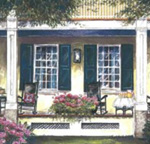
Frank Pietrucha
1926-2014
New Jersey based watercolorist
Frank Pietrucha attended the New York Workshop School of Design and the Newark School of Fine and Industrial Art, studying with noted artists John Grabach, E. Stanley Turnbull, Avery Johnson, and James Carlin. Pietrucha was mostly influenced by Reuben Nakien. His works are held in the collections of several major corporations and cultural institutions, such as the Newark Museum. He conducted seminars for professional associations and lectured at Princeton University, Rutgers University, Kean College, and Caldwell College, in addition to hosting a variety of art classes for the public in Somerset, NJ. Pietrucha was a member of the Somerset Art Association, the Art Directors Club of New Jersey, and the Essex Watercolor Club. His works have been exhibited at Brion Galleries and in group exhibitions at the Kosciuszko Foundation House Gallery in NYC, Newark Public Library, The Montclair Art Museum, The Albright-Knox Museum, the Doubletree Gallery, and many others.
|
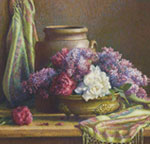
Pamela Pindell
b. 1950
American, contemporary realist figure, portrait and still-life painting
Pamela Pindell was born in 1950s in Elkhart, Indiana but grew up in the Finger Lakes district in central New York State. Her initial education was at Syracuse University but she transferred to Temple University so she could travel to Rome to study at the Tyler School of Art. She integrated her Classical Renaissance background with subsequent Boston School training with Sydney Willis and Robert Cormier. She was highly inspired by Caravaggio and Rembrandt for their style of painting, the power, the beautiful brushwork, and the strong chiaroscuro in the work.
As a Massachusetts artist, she has been exhibited widely in open juried shows, including annuals at the Salmagundi Club in New York, the Catherine Lorrillard Wolfe Art Club, and the Audubon Society. Her commercial exhibitions include eight previous solo and dual shows at Tree’s Place, these show include Capturing the Moment (2003), Painting from Life: The Human Figure (2002), Florals in the Style of the Boston School (2001), and In the Boston Tradition (1998).
Among many accolades, Pindell has won four within the last five years from the Guild of Boston Artists, including the prestigious Edmund Tarbell award. Her work has been recognized at other galleries such as, the Ogunquit Art Center, Nantucket Artist’s Association, the Hudson Valley Art Association, the Cape Cod Art Association and the American Pastel Society. She resides and maintains her studio in Boston.
|
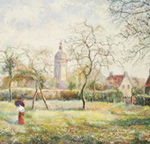
Hughes Claude Pissarro
b. 1935
French genre, landscape, seascape, and marine painter
Hughes Claude Pissarro is the grandson of the Impressionist painter Camille Pissarro and son of Paulemile Pissarro. Born in Neuilly-sur-Seine and enveloped in an artistic environment, he inevitably spent his childhood and youth with brushes in hand. Initially taught by his father, Hughes first exhibited his work at the age of fourteen. He then studied art in Paris at Ecole du Musee du Louvre and Ecole Normale Superior, a unique French institution dedicated to the pursuit of achievement and excellence to which only the academic elite have access. Hughes’ educational background led him to become a professor of art for much of his professional life and in 1965, he accepted an official invitation to teach art in Monaco. Throughout his teaching career, he was also a prolific artist exhibiting on several occasions in Paris and London. In 1959, he was commissioned to paint President Eisenhower. Hughes’ work has evolved through a variety of different styles and techniques, including abstract, avant-garde, minimalist, and conceptual art. However, he is best known for his Impressionist-style works.
|
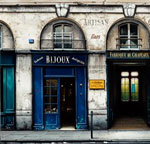
Thomas Pradzynski
b. 1951
Polish French Affiliated Realist
At the age of 26, Thomas Pradzynski left his native Poland for Paris with the aspiration of becoming an artist. The street scenes portrayed in Pradzynski’s paintings appear to be within the category of “realism.”
As a realist, Pradzynski focuses his composition on the amount of content he can add to the subject matter. In order to reveal more than one would ordinarily see with the naked eye, Pradzynski utilizes his talents of “photo realism.” Although Pradzynski maintains close tradition with Courbet in style, in theme he is more closely related to Edouard Manet. Manet believed that realism in technique could be mixed with myth in subject matter. Pradzynski’s painted buildings are not entirely true to their Parisian location and in their assemblage become fictional. Manet’s definition of Realism would still include Pradzynski’s fictitious arrangement of subject matter since his style remains true to life.
This theme of “fictitious Realism” found its way to the 20th Century and onto the canvases of contemporary artists. What makes Pradzynski’s work distinct is the psychological introspection that elevates it from mere reportage to poetry. Although one is tempted to react first to the work with a sense of nostalgia, one quickly realizes that this is not the emotional key with which to unlock meaning and beauty.
|
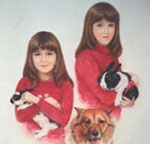
Jean Reasoner Plunket
-
20th Century portrait artist
Born into a family of artists, Jean Reasoner Plunket’s earliest interest was drawing and it was people she enjoyed drawing most. Having posed for her mother, Gladys Thayer Reasoner, as a small child and for renowned painter, Eugene Speicher, as an adolescent, Jean experienced portraiture from “both sides of the table.”
As the 21st century unfolds, Jean still draws people the old-fashioned way - from life - and her elite corps of sitters has grown to over 12,000, with more than 8,000 holding a special place in her unique sketch file which begun in 1953, entitled the Faces That Won’t Sit Still.
|
| |
|
| |
|
|


